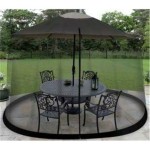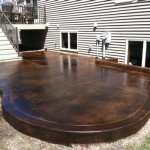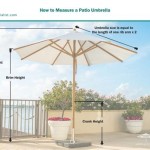Getting Rid of Flies On Your Patio
Flies are a common nuisance, particularly during warmer months. Their presence on patios not only detracts from the enjoyment of outdoor spaces but also presents potential health risks. Flies are vectors for various pathogens, carrying bacteria and diseases that can contaminate food and surfaces. Therefore, effectively managing and eliminating flies on patios is crucial for maintaining a clean, healthy, and enjoyable outdoor environment.
This article provides a comprehensive guide to understanding why flies are attracted to patios and outlines various strategies, ranging from preventative measures to active control methods, that can be implemented to eradicate flies effectively. The information presented aims to empower individuals with the knowledge needed to create a fly-free patio, allowing for a more pleasant and hygienic outdoor experience.
Understanding Fly Behavior and Attraction
Before implementing control measures, it is essential to understand why flies are attracted to patios in the first place. Flies are drawn to areas that provide food, water, and shelter. Decaying organic matter, such as food scraps, pet waste, and stagnant water, serve as breeding grounds and attractant sources. Understanding these attractants allows for targeted elimination and prevention strategies.
Different types of flies may be prevalent in different environments. House flies, blow flies, and fruit flies are among the most common types encountered on patios. House flies are attracted to a wide range of organic waste, while blow flies are particularly drawn to decaying meat. Fruit flies, as the name suggests, are attracted to fermenting fruits and vegetables. Identifying the specific types of flies present can help tailor control methods for greater effectiveness.
Weather conditions also play a significant role in fly activity. Warm temperatures accelerate the life cycle of flies and increase their breeding rates. Damp conditions, such as standing water after rain, provide ideal breeding environments. Conversely, extreme heat or cold can reduce fly activity. Monitoring weather patterns can help predict fly population fluctuations and inform the timing of control efforts.
Proximity to potential breeding sites, such as garbage bins, compost heaps, and animal enclosures, significantly increases the likelihood of flies infesting a patio. Flies can travel considerable distances to reach food sources, so even if the patio is kept clean, nearby breeding sites can still contribute to the problem. Identifying and managing these external sources is critical for achieving long-term fly control.
Finally, certain landscaping practices can inadvertently attract flies. Overwatering plants can create damp conditions that favor fly breeding. Dense vegetation can provide shelter and breeding sites. Choosing appropriate plants and maintaining proper drainage can help reduce fly attraction.
Preventative Measures: Creating a Fly-Unfriendly Patio
The most effective approach to managing flies on patios is to implement preventative measures that minimize their attraction to the area. These measures focus on eliminating food sources, breeding sites, and shelter, making the patio less hospitable to flies.
Regular cleaning is paramount. Food scraps, spills, and pet waste should be cleaned up immediately. Garbage bins should be tightly sealed and emptied frequently. Tables and chairs should be wiped down after meals. A clean patio is a less attractive patio to flies.
Proper food storage is crucial. Leftover food should be stored in airtight containers. Fruits and vegetables should be refrigerated or covered to prevent fruit flies from being attracted. Pet food should be stored in sealed containers and bowls should be cleaned after each feeding.
Eliminating standing water is essential for preventing fly breeding. Bird baths should be emptied and cleaned regularly. Potted plants should have proper drainage to prevent water from accumulating in saucers. Gutters should be cleaned to ensure proper water flow. Any other sources of standing water, such as puddles or leaky faucets, should be addressed promptly.
Effective waste management is vital. Garbage bins should be located away from the patio and tightly sealed. Compost heaps should be properly maintained to ensure they are not attracting flies. Pet waste should be disposed of promptly and hygienically. Considering fly-proof composting systems can further mitigate risks from attracting flies to the patio.
Strategic landscaping can also help. Choosing plants that are not particularly attractive to flies can reduce their presence on the patio. Pruning dense vegetation can eliminate shelter and breeding sites. Ensuring proper drainage can prevent the build-up of damp conditions that favor fly breeding.
Using screens on doors and windows can prevent flies from entering the house and subsequently finding their way onto the patio. Ensuring that screens are in good repair and properly fitted is essential for their effectiveness. Regularly checking and maintaining screens reduces entry points for flies.
Utilizing fans can deter flies. Flies are weak fliers and a gentle breeze can disrupt their flight patterns, making it difficult for them to land and feed. Strategically positioning fans can create an unfavorable environment for flies, encouraging them to seek alternative locations.
Active Control Methods: Eliminating Existing Fly Populations
While preventative measures are crucial, active control methods may be necessary to eliminate existing fly populations and address infestations. These methods range from traps and baits to insecticides, and should be implemented in conjunction with preventative measures for maximum effectiveness.
Fly traps are a common and effective method for capturing flies. Various types of fly traps are available, including sticky traps, light traps, and bait traps. Sticky traps are coated with an adhesive substance that traps flies upon contact. Light traps attract flies with ultraviolet light and then electrocute or trap them. Bait traps contain a lure that attracts flies, which then become trapped and drown.
Bait stations are another option for controlling fly populations. These stations contain a bait that is attractive to flies, typically a sugar-based or protein-based solution containing an insecticide. Flies are drawn to the bait, ingest the insecticide, and then die. Bait stations should be placed in areas where flies are frequently seen, but out of reach of children and pets.
Insecticides can be used to kill flies, but should be used with caution. Insecticides can be harmful to humans, pets, and beneficial insects. When using insecticides, it is essential to follow the manufacturer's instructions carefully. Consider using natural or organic insecticides that are less harmful to the environment and non-target organisms. Spot treatments, focusing on areas where flies congregate, are preferable to broad-spectrum applications.
Fly swatters are a simple and effective method for killing individual flies. While time-consuming, swatting flies can be a satisfying way to reduce their numbers, especially in small areas. Electric fly swatters can be more effective than traditional swatters, as they deliver a small electric shock that kills the fly instantly.
Professional pest control services can provide more comprehensive fly control solutions. Pest control professionals have the knowledge, experience, and equipment to identify the source of the infestation and implement targeted control measures. They can also provide advice on preventative measures to prevent future infestations. Consulting with a pest control professional is especially recommended for severe or persistent fly problems.
Natural remedies can also be used to repel flies. Certain plants, such as basil, lavender, and rosemary, are known to repel flies. Planting these herbs around the patio can help deter flies from entering the area. Essential oils, such as peppermint, eucalyptus, and citronella, can also be used as fly repellents. Diluted essential oils can be sprayed around the patio or used in diffusers.
Diatomaceous earth (DE) is a natural powder made from fossilized diatoms. It is effective at killing insects by damaging their exoskeletons, causing them to dehydrate and die. DE can be sprinkled around the patio or used to treat potential breeding sites. It is important to use food-grade DE, as other types of DE can be harmful to humans and pets.
:max_bytes(150000):strip_icc()/getting-rid-of-flies-outdoor-2656268_FINAL-729e4e7d8cd641dc9ccfaa659d73c98e.png?strip=all)
How To Get Rid Of Flies Outside On Porch Or In Backyard

How To Get Rid Of Flies On Your Outdoor Patio

How To Get Rid Of Flies Outside Quick Easy Methods

How Do You Get Rid Of Flies Outside Forbes Home

How To Get Rid Of Flies The Home Depot

4 Ways To Get Rid Of Flies Wikihow

How To Keep Flies Away Outside With Pennies Bag Of Water

How To Get Rid Of Flies Outside Quick Easy Methods

How To Keep Flies Away Outside With Pennies Bag Of Water
:max_bytes(150000):strip_icc()/getting-rid-of-flies-outdoor-2656268-hero-6a86867fc95d476da9d4a75133ca4c58.jpg?strip=all)
How To Get Rid Of Flies Outside On Porch Or In Backyard
Related Posts








